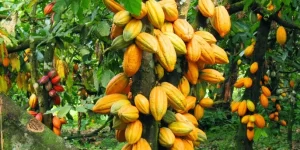What is chocolate?
Chocolate (sometimes called chocolate) is a delicacy made from cocoa powder , cocoa butter and sugar. The main component of chocolate is cocoa which comes from the cocoa tree (Theobroma cacao). The cocoa tree is on average 5 m high and flowers twice a year. Not all flowers become a cocoa fruit. Productivity depends on the age of the tree. After 5 years, the trees are more productive and can yield about 3 kilos of cocoa per year. The trees only grow in tropical forests between 20 degrees north and 20 degrees south of the equator; in countries with a tropical climate such as Ghana, Ivory Coast, Venezuela, Brazil, Mexico,.
How is chocolate made?
On a cocoa tree, which has 12 to 15 meters high, fruits grow that have a rugby ball-shaped pod and different colors depending on genetics and degree of ripeness. The pod is 8 to 14 inches long and grows directly from the main branches and trunk of the tree. The pod contains between 10 and 60 cocoa beans or seeds, depending on the size of the fruit. To make one 80 gram chocolate bar, we need about 30-35 cocoa beans. There are 3 types of pods of the cocoa tree, each with its own distinctive flavour: Forastero, Criollo and Trinitario. Of the three, Forastero is the most common. Criollo, on the other hand, is very rare and Trinitario is a hybrid of the other two.
1. Criollo: Also called “the prince of cocoa beans”. Criollo is a rare bean grown mainly in Central America and the Caribbean. The pod is soft, thin and light in color. Only a very small percentage of world production consists of this fragrant bean.
2. Forastero: More common and more productive, the Forastero trees have thicker pods and a strong chocolate flavor. Most cocoa is of this variety and it thrives in Brazil and Africa. It comes from the word “stranger” because it is not the original Central American criollo variety.
3 . Trinitario: Originating in Trinidad, this crossing of Criollo and Forastero is easy to grow. It has smooth pods and flavorful beans.
1. Harvesting the pods
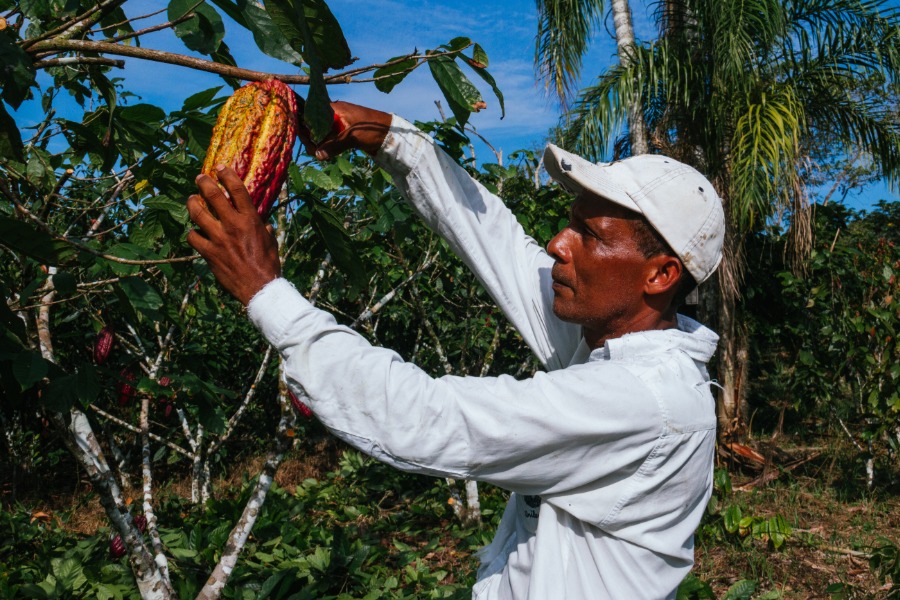
The harvesting of cocoa beans takes place twice a year. Following a tradition of over a thousand years, workers in the indigenous communities harvest the beans very carefully by hand. As they cannot climb the fragile trees, they use machetes or machetes to cut the lower pods and long-handled steel knives to cut the upper ones. The fruits are harvested when they are yellow. After picking the pods, the farmer scrapes out the white flesh and the seeds. There are between 10-60 seeds or cocoa beans embedded in juicy, sweet and sour creamy white pulp of the pod.
2. Fermenting
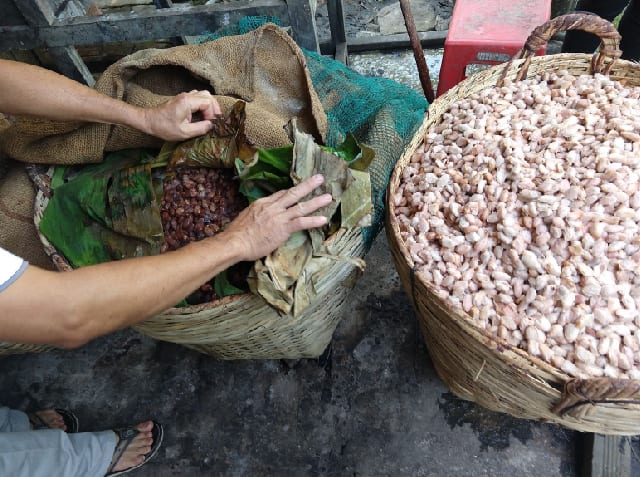
Then comes the fermentation process. Through fermentation, the seed begins to acquire the characteristics that we recognise as chocolate. Now that the cocoa beans have been extracted from the fruit, the farmer spends 2 to 8 days putting the beans in baskets or in large wooden boxes, or rakes them in heaps and covers them under banana leaves to ferment. The seeds ferment by heating to 125 degrees. During the fermentation process, the sugars of the seeds are converted into acid and enzymes break down the bitterness to produce important precursors of the chocolate taste. This process is very important for the quality of the cocoa because during fermentation, the germination is stopped and reactions are started which make the bitter taste disappear. After these few days, the bean has developed its characteristic aroma and the white beans have turned brown.
After this step, the contents are spread out on a single layer to dry, usually under direct sunlight. They are ready to be exported to factories in North America and Europe where the beans are cleaned, sorted and roasted.
3. Roasting the cocoa beans
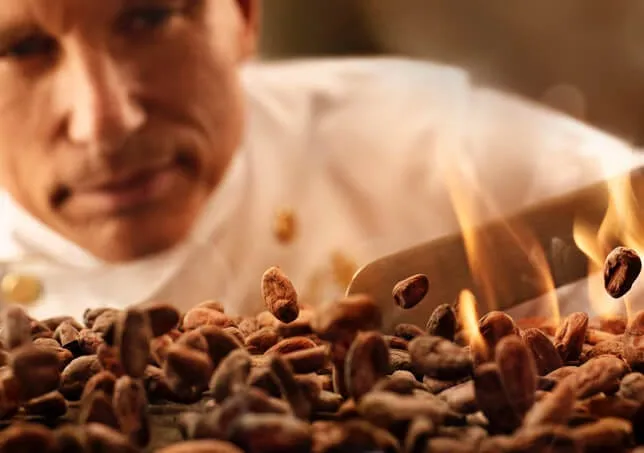
The roasting of cocoa beans is an important step in the process of developing chocolate flavour and colour. The techniques used to roast cocoa beans must be appropriate to the type of bean being roasted. Particular attention should be paid to the size of the bean, its plumpness, moisture content, variety and its unique flavour profile.
4. Peeling the beans
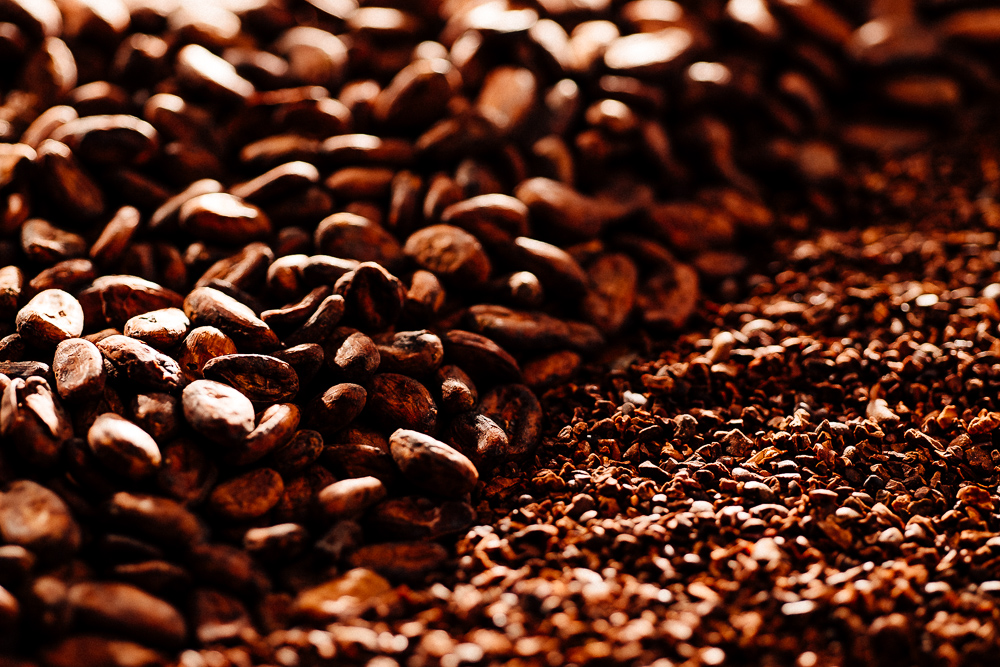
After roasting, the cocoa beans are cooled and then separated from their shells by breaking and peeling them with a wan. The early Mayans did this by hand in a stone mortar. This tool removes the shell of the cocoa bean, leaving behind the nibs which are used to produce the chocolate.
5. Grinding or pressing
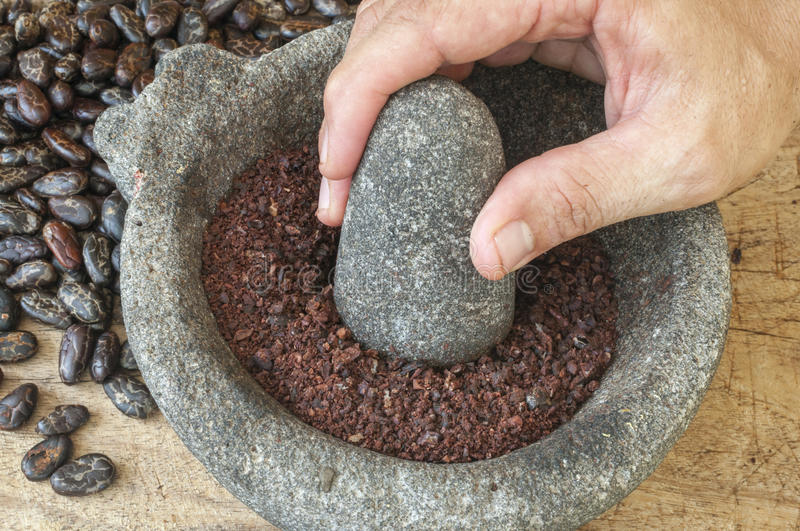
Then they are ground very finely and turned into a thick liquid, the cocoa mass. Through the pressure and friction of the stones, the natural fat in the nibs melts into a liquid form. This liquid is called chocolate mass. This mass is the basic raw material for all chocolate products and is separated into cocoa butter and a solid press cake by means of ‘pressing’: solid cocoa. This solid cocoa is again ground and sieved into powder and processed into cocoa powder.
6. Conching

Conching is a kneading or smoothing process used to further develop the taste and texture of chocolate After rolling, the mass is still too dry and does not have the right taste yet. The chocolate mass must first be ripened at a temperature of 45 to 50 °C for 24 hours. Then the ripened mass is heated at 80 °C for 6 to 12 hours. Some of the volatile acids disappear and the humidity level is lowered. This has a positive effect on the keeping quality and viscosity. The fat distribution becomes uniform: each cocoa particle is covered with a layer of fat. This is necessary to give the chocolate the desired flow characteristics with as little fat as possible. This fat phase also brings an increase in homogeneity.
7. Tempering

Once the mixture has condensed, it is transferred to the tempering machine, where it is heated, cooled and reheated. The melted chocolate mash is cooled down from 50 °C to 18 °C in ten minutes, after which the temperature rises again to around 30 °C. The exact values can vary according to the composition. This process is used not only to better preserve the chocolate, but also to give it a smooth and creamy texture and a shiny appearance. This tempering also prevents discoloration and fat bloom on the finished chocolates so that crystalline forms of cocoa butter do not form on the chocolate.
8. Pouring into moulds

The liquid chocolate is then poured out of the tempering machine into moulds or dies to give it the desired shape. This is how the delicious mash is given a shape, such as bars, pralines, Santa Claus figures, Easter eggs, bonbons and all sorts of other figures, depending on the time period, the target group and the occasions for which the chocolate is intended.
9. Cooling and packaging
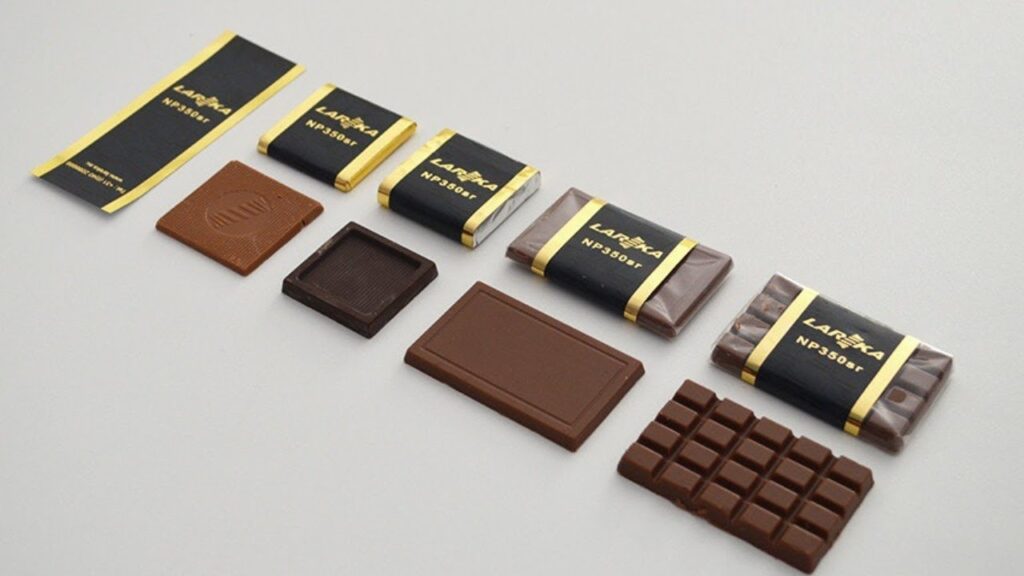
This process is carried out to solidify the liquid chocolate into chocolate bars or other shapes. The time needed depends on the type of chocolate. The higher the percentage of cocoa, the less time is needed to harden. Once cooled, it is ready to be wrapped in a nice looking package so that it stands out when it hits the shelves, ready for the consumer! Mmm.
This short video shows easily the process from cocoa bean to chocolate bar
Is chocolate healthy?
Is chocolate healthy or not? Much has been written about the health effects of this sweet treat. Which statements are true?
When I talk about any health effects of chocolate, I mean the dark chocolate that contains at least 70% cocoa. Chocolate is the healthiest when it has not yet been processed into bars that you can get on the shelves of a store or department store. There is already a bottleneck here…
Cocoa beans and cocoa contain a lot of antioxidants that the body needs. The main antioxidants in cocoa are flavonoids. Flavonoids are not as well known as vitamins and minerals, but just as important for health. These antioxidants are known for their protective ability and tcombating premature aging. Flavonoids can be found, for example, in fruit and green tea. And cocoa contains a class of flavonoids known as the flavanols (read more about the flavonoids), But cocoa contains the highest amount of flavonoids of all foods, even much more and more potent flavonoids than green tea, which is already known to contain a lot of flavanoids.
The effects of chocolate on blood pressure, cardiovascular function and insulin response
Studies do show that dark chocolate has a beneficial effecton heart and blood vessels, lowering blood pressure[1] and less sticky platelets.[2] In addition, dark chocolate causes a better insulin response. Which means the body can better process and store sugar, so that sugar stays in the bloodstream for a shorter time and can reach all kinds of tissues where it can cause damage, such as in the brain, eyes, kidneys or blood vessel walls. In “pre-diabetics” (pre-diabetes is the stage for diabetes or diabetes. Prediabetics have a blood sugar or glucose level higher than normal, a glycemia value between 100 and 125 mg/dl, but not yet high enough to speak of type 2 diabetes who have a blood glucose value above 125 mg/dl) , eating a piece of dark chocolate for 15 days, the insulin response became twice as strong! In addition, their diastolic blood pressure dropped by almost 5 points, which is better than many blood pressure medications…
But the cocoa ingredient has a lot more in store. For example, a study was conducted among the Kuna Indians who live on a group of islands off the coast of Panama. The Kuna Indians drink large amounts of hot cocoa powder, mixed with water, up to 4-5 cups a day. They are known for their good health. The blood pressure of the Native Americans living on the San Blas Islands hardly increases with age. In the West, on the other hand, high blood pressure is a disease that affects 30% of the population. The average blood pressure in the elderly of the inhabitants of the San Blas Islands is 110/70, which is very low. At first, the doctors thought that the cause of their low blood pressure was due to good genes. But apparently the Kuna who had moved to the cities saw that they had a much higher blood pressure, just like the people of Western society.
The scientists were astonished when they examined 78,000 death certificates of the Kuna who lived on the islands and the Kuna who had moved to the mainland. The mortality from cardiovascular disease among the people living on the islands was nine times lower than among the Kuna on the mainland. Cancer was 16 times less common and diabetes was 4 times less common.[3] So it didn’t really have anything to do with good genes, because then both groups would be equally should be healthy, which is not the case.
You can’t just attribute this better health to cocoa, of course. The kuna on the islands also ate much healthy and more vegetables, fruits and fish than those who lived on the mainland, who mainly had a Western diet.
Studies also show that the flavanols in cocoa had good effects on the heart and blood vessels. In the study, published in The American Journal of Clinical Nutrition, researchers examined more than 20,000 American adults ages 60 and older. The people were followed over the course of five years, with the diets of some participants being supplemented with cocoa extract. Those receiving the supplement were significantly less likely to die from cardiovascular disease.
“We found that cocoa flavanol supplementation can reduce clinical cardiovascular events, including a statistically significant 27% reduction in death from cardiovascular disease (CVD) ,” said study author Howard D. Sesso.[4]
After reading this, you may be convinced of the health of chocolate and now you’re flying to the cupboard to look for a chocolate bar. Wait a minute… Some important caveats…
[1] Davide Grassi, Stefano Necozione, Cristina Lippi, et al. Cocoa Reduces Blood Pressure and Insulin Resistance and Improves endothelium-dependent vasodilation in Hypertensives. Hypertension, 2005, 46: 398-405
https://www.worldcocoafoundation.org/wp-content/uploads/files_mf/grassi2005humannutritionbloodpressure.pdf
[2] Roberta R. Holt, BS; Derek D. Schramm, PhD; Carl L. Keen, PhD; et al. Chocolate consumption and platelet function. JAMA, 2002, 287, 1212-1213.
[3] Vicente Bayard, Fermina Chamorro, Jorge Motta, and Norman K. Hollenberg. Does Flavanol Intake Influence Mortality from Nitric Oxide-Dependent Processes? Ischemic Heart Disease, Stroke, Diabetes Mellitus, and Cancer in Panama. Int J Med Sci. 2007; 4(1): 53–58. https://www.ncbi.nlm.nih.gov/pmc/articles/PMC1796954/
[4] Howard D Sesso, JoAnn E Manson, Aaron K Aragaki, Pamela M Rist, Lisa G Johnson, et al. Effect of cocoa flavanol supplementation for prevention of cardiovascular disease events: The COSMOS randomized clinical trial. he American Journal of Clinical Nutrition, nqac055, https://doi.org/10.1093/ajcn/nqac055
Published: 16 March 2022
Is milk chocolate healthy too?
.
You now know that the cause of the positive effect is the flavonoids. However, flavonoids are only found in dark chocolate containing cocoa. This means that white chocolate and milk chocolate are not included. Dark chocolate contains the most cocoa. If you want to eat the healthiest kind of chocolate, eat dark chocolate. But not all dark chocolate is equally healthy.
The flavanol content of chocolate depends on many other factors. These include the type of cocoa tree, the region where it grows, the weather conditions during growth, the time of harvest and the storage period after harvest. Some of the flavanols are lost during the roasting of the cocoa beans and the preparation of chocolate. Therefore, “raw cocoa powder” and “raw chocolate” have a higher content of flavanols
What is raw chocolate?
But what is meant by raw? Normally cocoa beans are heated at very high temperatures. As a result, a large part of the flavonoids is lost. Sugars and fats are added, resulting in an unhealthy bar of dark chocolate. With raw chocolate, the cacao beans are heated to a temperature of no more than 46 degrees, so that most of the flavonoids are retained. No sugars are added either. Always choose dark chocolate with the highest possible cocoa content. A cocoa content of 85 per cent is ideal. But when I ate a piece of raw chocolate for the first time, it didn’t taste very good. I had to learn to eat it. Real dark chocolate is very bitter. But by eating it regularly, I began to have less and less aversion to its bitterness. I learned to eat it. For those for whom more than 80% is too bitter, a 70% cocoa content can still provide plenty of benefits.
But no matter how healthy raw chocolate might be, it can never be part of a healthy diet. In fact, it has been scientifically proven that 10 grams of raw chocolate is enough. For good health, vegetables, fruit and exercise remain the most important.
Potassium
Lorem ipsum dolor sit amet, consectetur adipiscing elit. Ut elit tellus, luctus nec ullamcorper mattis, pulvinar dapibus leo.
Video: Documentary "For the love of Chocolate" with Katja Schuurman
National Geographic Channel aired a documentary “for the love of chocolate” in December 2012. Katja Schuurman will investigate how cocoa can be harvested sustainably and will travel through the world of chocolate and cocoa in the Netherlands and Ghana.


